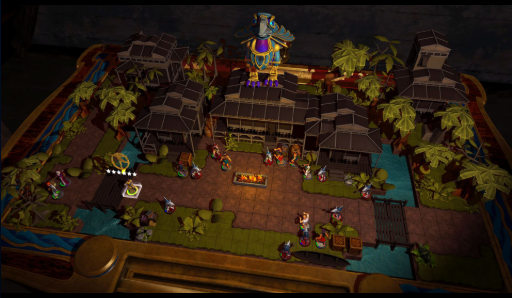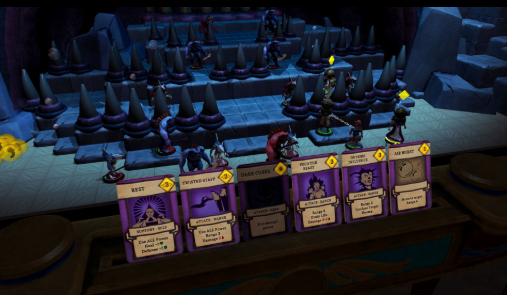In this issue of Mr. PSVR’s Interview Corner, we talk with Neil Rennison of Tin Man Games and get into some of the games that they have been responsible for and learn more about their newest game, Table of Tales: The Crooked Crown. A game that brings to life the tabletop game genre, a narrative-driven campaign, and how being a scoundrel can sometimes lead to being a hero in ways that only Virtual Reality can. We also find out what Neil’s top three tips when it comes to starting working in Virtual Reality.



Welcome to The PlayStation Brahs. Could you please introduce yourself and let everyone know what you do at Tin Man Games?
“My name is Neil Rennison and I am the founder and creative director at Tin Man Games.”
For those that may not be aware, what are some of the games or projects that Tin Man Games have been responsible for or helped make into a reality?
“We have worked on over 35 games and apps for mobile phones, tablets, desktop computers, and more recently Nintendo Switch and PlayStation VR. Most of our games and apps have been based on adventure gamebooks from the 80s and 90s based on a number of licenses such as Fighting Fantasy, Judge Dredd, Warhammer 40,000 and Miss Fisher’s Murder Mysteries. Around three years ago we released our first big 3D digital board game, The Warlock of Firetop Mountain, based on the classic 1982 gamebook written by Ian Livingstone and Steve Jackson. That sowed the seeds for Table of Tales!”
So, Table of Tales: The Crooked Crown came out on April 16th, 2019, what type of feedback has the team receive and were there anything that really surprised you by them?
“Most of the feedback has been really positive – we’re super pleased! There have been some great reviews popping up online. Nothing has surprised me that much to be honest because I knew we were making something almost unique and a little bit special. Many of the positive comments we get justify many of the design decisions we tool across the development, and that’s great to read, especially as many of them took many hours of design iteration until they felt just right.”

Can you share some of the back story and inspirations on how the idea Table of Tales: The Crooked Crown come about?
“After The Warlock of Firetop Mountain we wanted to do another digital board game. VR was in ascendency so we approached Sony with the pitch, “What would happen if you took the movie Jumanji, mixed it with Dungeons and Dragons, and threw it into virtual reality?”.

When I first played, I accidentally dropped a scoundrel off the table and received a trophy. Are there any other trophies that no one has discovered yet, but were so close to discovering?
“It’s been a while since I saw the trophy list but I know the team thought up some clever angles for those, so you may have missed some. I know some players have found them all!”
I loved how Arbitrix played the Game Master and was telling the story as the action was unfolding on the table. Was this always the plan and was Arbitrix ever going to be something different from the beginning?
“Yes, we always wanted a dungeon master of sorts that interacted with you. Originally Arbitrix was going to be a floating mask that talked to you, but we felt we couldn’t imbue it with enough personality so our concept artist went back to the drawing board. He came up with some bird designs and we settled on one particular one that wasn’t far away from what Arbitrix became!”

Of course, the main focal point is the table, how many times did the idea for the table change before it was finally decided on with the look and how it would be a focal point of the game?
“It changed a lot! In early iterations there was a dice-dispensing machine, lots of buttons to press and even a giant kraken carved into the wooden backboard. As we iterated the design and play-tested we realized that all that extra detail was unnecessary, because the way the table shifted and moved to form the environments needed to be the main heartbeat of the table.”
Was there ever a plan to have online multiplayer or any future DLC?
“No, sadly not. We’re a small company and the scope of something that large was way beyond us at the time. Things have changed though and we may look into online multiplayer digital board games in the future. Whether that is in the form of another Table of Tales, or something else is still to be decided.”

Are there any plans for a sequel or maybe a different story with a different setting, but still with the same type of style that you can talk about?
“We would love to – the table has lots more stories to tell. If it sells well or if we’re approached with funding to do another then we’d be foolish not to.”
When it came to PlayStation VR, were there some things that maybe you were not expecting that you had to learn?
“Making games in VR is very different to making “flat-screen” games. UI is a major hurdle to get over as you can’t have an interface with buttons like you can in regular RPG-style games. Therefore, you need to design the environment so that the player can interact in such a way that they can still do the things that they expect in a game of that genre. A good example is the cards that are generated by the table and act as buttons to activate the player characters’ skills. Instead of tapping a traditional UI activate ability button, you pick up the card and move it over the character, enemy or environment location to activate it. In VR that feels very intuitive as you that is how you would interact with a card and board game in real-life.”
What would be the top three things you would tell someone who was looking to start working with VR?
- The player always comes first. VR is true first-person, and such you need to remember that the player believes they are inside a magical dimension that they can interact with. Your game always needs to cater to that and not all game genres and playing styles work.
- Don’t over-complicate interactions. Doing lots of different crazy stuff can be a fun novelty for a while, but quickly becomes tiring. Keep a minimum of interactions and make them feel truly wonderful. Beat Saber is a great example of this.
- Different VR systems have different audiences and controller schemes. Always bear that in mind and design for a particular system as it will always feel more immersive for those players.”
With the PlayStation VR catalog growing, what would you say to someone who was looking on why they should get Table of Tales: The Crooked Crown?
“Table of Tales is one of the very first-ever tabletop RPG experiences in VR. In years to come, I can imagine there will be many, many more and I see Table of Tales as a major landmark in that evolution. If you love VR and have even a passing interest in board games or role-playing games then prepare to have your perception of what is possible in this space changed forever.”

I really want to thank Neil Rennison of Tin Man Games for taking time out of his busy schedule and I also want to thank Amelia Laughlan for setting everything up.
Table of Tales: The Crooked Crown is out now on PlayStation VR.
Also, check out the review.
To learn more about Tin Man Games, please visit their site, like them on Facebook, follow them on Twitter, and subscribe to their YouTube channel.
In case you missed the trailer, please enjoy.
Mr. PSVR, May 7, 2019, theplaystationbrahs.com

